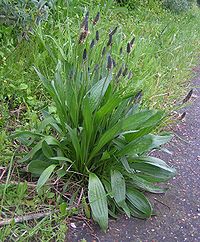
Photo from wikipedia
Abstract A population of buckhorn plantain with suspected resistance to 2,4-D was identified in central Indiana following 30 yr of 2,4-D-containing herbicide applications. Our objectives were to (1) confirm and… Click to show full abstract
Abstract A population of buckhorn plantain with suspected resistance to 2,4-D was identified in central Indiana following 30 yr of 2,4-D-containing herbicide applications. Our objectives were to (1) confirm and quantify the level of herbicide resistance in the buckhorn plantain population using dose-response experiments and (2) find alternative herbicides that could be used to control this population. Greenhouse experiments were conducted to quantify the dose-response of resistant (R) and susceptible (S) biotypes of buckhorn plantain to both 2,4-D and triclopyr, two synthetic auxin herbicides from different chemical families. The R biotype was ≥6.2 times less sensitive to 2,4-D than the S biotype. The efficacy of triclopyr was similar on both the R and S biotypes of buckhorn plantain, suggesting the absence of cross-resistance to this herbicide. This is the first report of 2,4-D resistance in buckhorn plantain and the first report of 2,4-D resistance in turf. The resistance mechanism was limited to within a chemical family (phenoxycarboxylic acid) and did not occur across all WSSA Group 4 synthetic auxin herbicides, as the pyridinecarboxylic acid herbicides clopyralid and triclopyr and the arylpicolinate herbicide halauxifen-methyl provided control in our experiments. Nomenclature: 2,4-D, clopyralid, halauxifen-methyl, triclopyr, buckhorn plantain, Plantago lanceolata L. PLALA
Journal Title: Weed Technology
Year Published: 2018
Link to full text (if available)
Share on Social Media: Sign Up to like & get
recommendations!